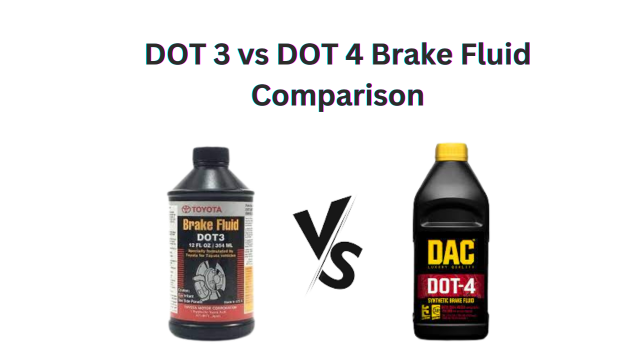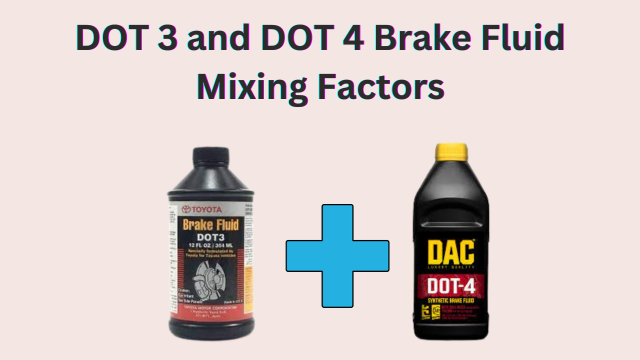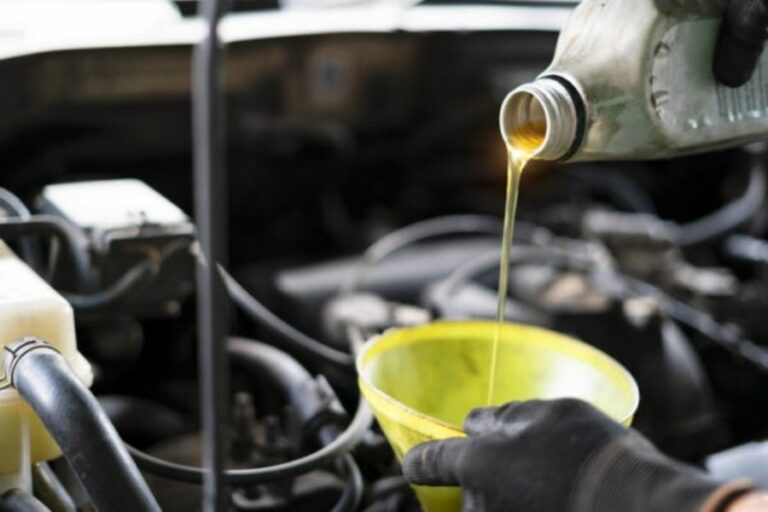Can You Mix DOT 3 and DOT 4 Brake Fluids? A Complete Guide
Choosing the suitable brake fluid out of options like DOT 3 and DOT 4 can significantly impact how often and how much you spend on car repairs.
Is it safe to mix DOT 3 and DOT 4 brake fluids? The answer is yes. These glycol-based brake fluids are made for hydraulic brake systems to work together chemically. Mixing the two allows you to develop adaptable solutions that do not compromise safety or functionality.
In this article, we will compare the differences between DOT 3 and DOT 4 brake fluids, mixing procedures, and other factors.
You may also read Why is my Brake Fluid Green?
DOT 3 vs DOT 4 Brake Fluid Comparison

Brake fluid is essential to your car’s braking system because it keeps everything stable. Regarding brake fluid, drivers should understand the difference between DOT 3 and DOT 4. Despite their compatibility, their differences can help you decide the most suitable brake fluid.
Composition
One of the most noticeable differences between these fluids is their composition. Thus, the primary constituent of DOT 3 brake fluid is glycol ethers. At the same time, DOT 4 consists of both glycol ethers and borate esters. Moreover, DOT 4 is more effective than DOT 3 because it contains borate esters in addition to esters, whereas DOT 3 only contains esters.
Boiling Points
The point at which a liquid transforms into a gas is called its boiling point. Additionally, a liquid’s boiling point may be dry before water absorption and wet after water absorption.
In particular, DOT 4 brake fluid is more resistant to high temperatures than DOT 3 because it has higher boiling points under both dry and wet conditions. Thus, DOT 4 brake fluid with a higher boiling point improves safety and braking efficiency by preventing air bubbles in brake lines.
DOT 3 vs DOT 4 – Reliability
The boiling point of DOT 4 is higher, which makes it better for situations where the brakes get very hot, like racing, driving aggressively, or in cars with traction control or ABS.
- DOT 3 wet boiling point: 205°C/401°F
- DOT 3 dry boiling point: 140°C/284°F
- DOT 4 wet boiling point: 155°C/311°F
- DOT 4 dry boiling point: 230°C/446°F
Water Absorption
The hygroscopic nature of brake fluids means they also gradually absorb moisture from the surrounding air. Consequently, DOT 3 absorbs about 2% more water yearly than DOT 4 due to its lower wet boiling point. When too much water is in a fluid, its boiling point and frictional properties suffer.
Note: DOT 3 and DOT 4 fluids have different moisture levels, so regular fluid changes are recommended.
Compatibility
It is usually suggested that DOT 3 and DOT 4 be mixed in a car’s brake system after it has been flushed completely. Most experts agree you should follow the manufacturer’s guidelines when mixing brake fluids.
Because DOT 3 is compatible with materials like aluminum, copper, and iron alloys, you should mix DOT 3 and DOT 4 fluids. Conversely, DOT 4 has stronger anticorrosive properties.
Price
DOT 3 is typically the more economical option when comparing the price. But DOT 4 might be a better deal in the long term due to its higher boiling points and long-term system protection, particularly in situations that demand high performance.
People Also Read What Happens If You Overfill Brake Fluid?
DOT 3 and DOT 4 Brake Fluid Mixing Factors

There are a few things to remember when choosing brake fluid for your car’s hydraulic braking system, and doing so will help you apply the brakes more safely and effectively.
Manufacturer’s Guidelines
If you want to know more about compatibility before mixing brake fluids, look at the owner’s manual or the manufacturer’s instructions.
- Many automakers recommend using only DOT 3 or DOT 4 brake fluid.
- Mixing fluids without checking can cause leaks, corrosion, and braking issues.
- Follow your vehicle’s braking system manufacturer’s instructions.
- Do not mix silicone or petroleum-based brake fluids with DOT 3 or DOT 4.
Moisture Check
Eventually, old brake fluid will absorb moisture from the air, significantly lowering its boiling point. Assume the old brake fluid in your system has already caused considerable moisture contamination. In such a scenario, it is preferable to replace the old fluid with a fresh one and flush the entire system instead of adding more.
Understanding Boiling Points
If you mix DOT 3 and DOT 4 brake fluid, the new fluid will have a boiling point in the middle of the two. So, the boiling point of DOT 4 fluid is significantly higher than that of DOT 3 fluid.
It is, therefore, essential to determine if the mixture’s lowered boiling point satisfies the needs of your braking system. Although the boiling point difference is relatively insignificant, it is necessary for the efficiency of the braking system.
Full Bleeding
When replacing any old fluid in the calipers, cylinders, or lines, it is necessary to bleed the brakes with new fluid completely. Meanwhile, begin bleeding with the wheel farthest from the master cylinder.
In addition to eliminating fluid pockets and moisture contamination, complete bleeding removes any trapped air bubbles and moisture contamination from the system.
Read this Why is No Brake Fluid Coming Out When Bleeding?
Normal Mixing Ratio
Before filling the brake fluid reservoir, thoroughly blend the DOT 3 and DOT 4 brake fluids in the prescribed 50/50 ratio. Putting different amounts of fluids directly into the reservoir can create areas with varying points of boiling, moisture levels, and fluid mixes.
Note: It is recommended that you first mix the brake fluids outside.
Brake Fluid Monitoring
Keep an eye on the level and condition of the brake fluid reservoir regularly. As time passes, absorbing moisture will lower the boiling point and make it less valuable. After flushing the system, replace the fluid according to your vehicle’s repair manual. Furthermore, keep old, contaminated fluid out of the system.
Mixing DOT 3 and DOT 4 Brake Fluid: A Step-by-Step Guide
When it comes to your vehicle’s braking system, mixing DOT 3 and DOT 4 brake fluids requires careful attention. To avoid getting into trouble, carefully follow these steps.
Step 1: Understanding Brake Fluids
Suppose you compare the dry and wet boiling points of DOT 3 and DOT 4 brake fluids. In that case, you will notice that the latter can withstand higher temperatures before evaporating. DOT 3 fluid comprises glycol ether, whereas DOT 4 comprises polyglycols, borate ester, and glycol ether.
When mixing the fluids, adhere to the manufacturer’s instructions. Remember that DOT 3 or DOT 4 brake fluids should never be mixed with petroleum- or silicone-based brake fluids.
Step 2: Get Ready to Mix Brake Fluid
Before mixing in new brake fluid and adding it, several precautions need to be taken to ensure everyone’s safety, including the following:
- Park on a flat surface and apply the brakes to fill and bleed your vehicle without any problems.
- Find the brake fluid reservoir, lines, master cylinder, and bleeder valves and examine their locations and configurations.
- Scrub all brake parts to eliminate old fluid, dirt, and grime that could contaminate the new fluid.
- Protect any freshly painted walls from spills by placing a tarp over the reservoir.
- You will need fresh containers for the brake fluid, rags, bleeder wrench, and funnel.
Step 3: Brake Fluid Mixing
After finishing the necessary steps for preparation, you will be able to combine the two types of brake fluid as follows:
- Put 50/50 of DOT 3 and DOT 4 brake fluid into a separate, clean container to mix them thoroughly.
- Mixing the brake fluid outside the reservoir before adding or mixing it is essential. It’s because pockets of different fluids may form.
- Brake fluid loses its boiling point as it absorbs moisture, so only mix small amounts at a time.
Step 4: Remixing the Brake Fluid
Once the brake fluid mixture has been thoroughly mixed, you can fill the brake system reservoir with the fresh mixture.
- Fill the reservoir properly with the newly formulated DOT 3 and DOT 4 mixture.
- Brake fluid can cause serious damage to painted surfaces and should be kept away from them at all costs.
- Hold the parking brake down firmly and keep the car on a flat surface.
Step 5: Brake testing and bleeding
Bleeding the brakes before testing them on the road helps to guarantee that the fresh fluid is dispensed uniformly:
- Start bleeding the brakes at the wheel cylinder, caliper, and tube farthest from the master cylinder reservoir, and work your way back.
- After bleeding, bring the reservoir to “Full” and secure the cap.
- Try different braking pressures and speeds in a safe area to test the vehicle.
Can I use dot 4 instead of dot 3?
Yes, you can use DOT 4 brake fluid instead of DOT 3. DOT 4 brake fluid has a higher boiling point than DOT 3 brake fluid, which means it is less likely to boil under heavy braking conditions. This is why DOT 4 brake fluid is often recommended for high-performance vehicles or vehicles that are driven in stop-and-go traffic.
Bottom Line
Mixing DOT 3 and DOT 4 brake fluids can make your brake system more flexible. When using the equipment, adhere to the manufacturer’s instructions, mix and bleed the system completely, and take all necessary safety precautions. However, it is necessary to proceed with caution and accuracy.
Your brakes play a major role, so finding the right boiling point for your needs and preventing contamination is essential. Similarly, it is a good idea to check the fluid levels regularly. Finally, how carefully you apply the brakes affects the safety and effectiveness of your braking system.







